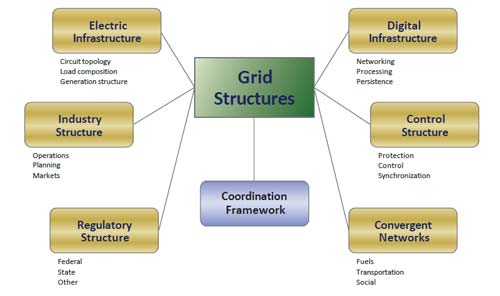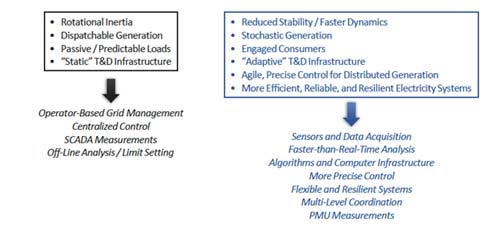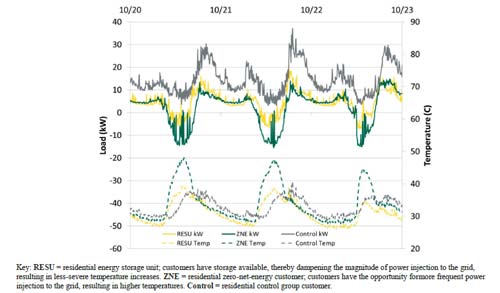| 1. |
According to figure 3.1, the U.S. electric power system is the centerpiece of the nation’s energy economy. Of the roughly 97 quads (quadrillion British thermal unit) of energy used in the United States in 2014, about 38 quads were transformed into 3,900 terawatt-hours of electricity for delivery by an extensive infrastructure of more than 19,000 generators, 55,000 transmission substations, 642,000 miles of high-voltage lines, and 6.3 million miles of distribution lines to serve 145 million customers. |
|
|
38.4 |
|
|
34.8 |
|
|
27.5 |
| 2. |
According to figure 3.2 the traditional electricity system was based on: |
|
|
Large-scale generation, centralized one way control, and passive loads. |
|
|
.Generation stations. |
| 3. |
According to figure 3.3 the evolution of the electric power grid includes: more distributed control, two-way flow of electricity and information, more energy storage, and new market participants including consumers as energy producers. |
|
|
True |
|
|
False |
| 4. |
Which one of the following drives the changes in this transformation?
- Changing mix and characteristics of electricity generation sources that are shifting electricity generation from relatively few large central station plants to many smaller and sometimes variable generators
- Changing demand loads in retail electricity markets resulting from demographic and economic shifts; the adoption of more energy-efficient, end-use technologies; growing consumer participation; broader electrification; and use of electronic converters (rather than induction motors and other types of loads with favorable inertia and droop curves)
- Integration of smart grid technologies for managing complex power systems, driven by the availability of advanced technologies that can better manage progressively challenging loads
- Growing expectations for a resilient and responsive power grid in the face of more frequent and intense weather events, cyber and physical attacks, and interdependencies with natural gas and water systems
- Aging electricity infrastructure that requires new technologies to enable better failure detection, upgrade capabilities, and improve cybersecurity
|
|
|
1, 3, and 5 |
|
|
All of the above |
| 5. |
The traditional electricity architecture was designed for “passive” loads, communications with distributed components were not necessary. |
|
|
True |
|
|
False |
| 6. |
Currently, 70% of large power transformers and transmission lines are twenty-five years or older, and 60% of circuit breakers are thirty years or older. A catastrophic failure of a transmission asset threatens system reliability and changing system dynamics may increase the likelihood that this can happen. |
|
|
True |
|
|
False |
| 7. |
According to Figure 3.8 many of the cascading events occurred in intervals of less than _____________________________ seconds, R&D is needed to perform state estimation in less than one second to allow operators the ability to detect and respond to cascading events. |
|
|
Twenty seconds and some in intervals of less than five seconds |
|
|
Ten seconds |
| 8. |
The grid can be viewed as six interrelated structures and a coordination framework to understand the needs and requirements necessary to meet the performance expectations of a digital economy.
 |
|
|
True |
|
|
False |
| 9. |
Figure 3-12 shows the fundamental difference between the Historical and emerging power system.
 |
|
|
True |
|
|
False |
| 10. |
Figure 3-17 shows:
 |
|
|
Excessive transformer heating from reversed power flows |
|
|
Electricity usage of network PMUs across the United States and Canada |
| 11. |
Bulk energy storage technologies are characterized by large storage capacities and long discharge times that are generally used to shift large amounts of electricity. PHS and compressed air energy storage (CAES) are two technologies capable of discharge times _____________ with power ratings that can reach 1,000 MW or more. |
|
|
In tens of hours to days |
|
|
From a few weeks to 6 months |
| 12. |
Batteries are a broad family of devices that store and release electric energy through electrochemical reactions. Battery technologies have been successfully deployed in both distributed and centralized applications in various sizes and can be used for both energy and power applications. However, they have not yet realized widespread deployment because of challenges in: |
|
|
energy density, power performance, lifetime, charging capabilities, safety, and system life cycle cost, inclusive of waste and disposal. |
|
|
Climate change spikes and seasonal storms. |
| 13. |
Power technologies can be charged and discharged relatively quickly, but they tend to suffer from limited energy storage capacity. These technologies are often used in applications such as frequency regulation, power quality, and as an uninterruptible power supply. |
|
|
True |
|
|
False |
| 14. |
Hydrogen energy storage (HES) systems typically involve the production of hydrogen from electricity via electrolyzers in which electrical energy is used to split water molecules into hydrogen and oxygen gas. This hydrogen |
|
|
can be stored or used in other sectors such as manufacturing, transportation, or end use. |
|
|
cannot be stored or used in other sectors such as manufacturing, transportation, or end use. |
| 15. |
According to figure 3.22, the highest number of unplanned outages are caused by weather, faulty equipment, and unknown circumstances. |
|
|
True |
|
|
False |
|